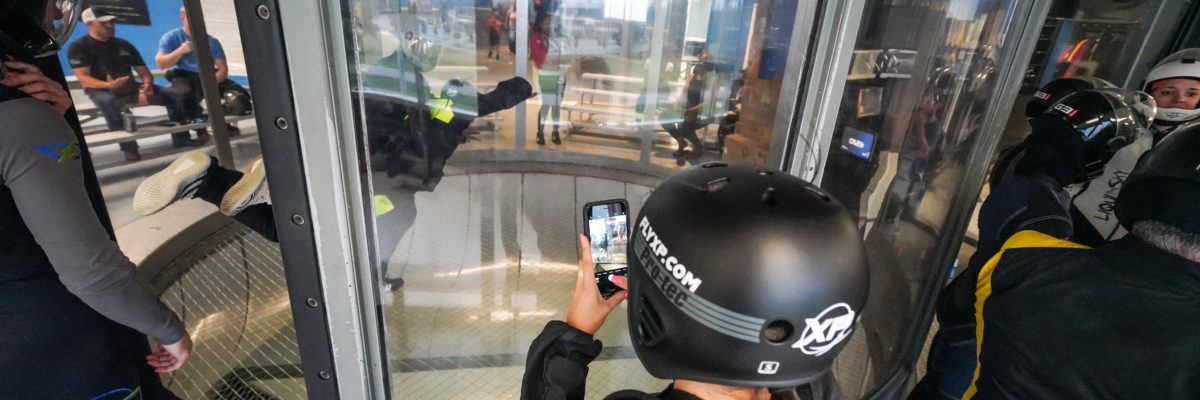
How Paraclete XP helped advance indoor skydiving’s evolution
Saturday, August 22, 2020
- Team XP
- 8/22/20
- 0
- Indoor Skydiving
Indoor skydiving is the amalgamation of innovation, ingenuity and a captivation with flight that spans the entirety of modern man’s existence. Today, there are wind tunnels all across the country, but few have helped advance indoor skydiving or operate with the capabilities of the Paraclete XP wind tunnel.
Size Matters In Indoor Skydiving
Prior to the opening of Paraclete XP, the largest wind tunnel in the United States had a diameter of 14 feet. In 2008, when Paraclete XP opened its doors, they offered something new: a wind tunnel that was 56 feet tall and 16.5 feet in diameter. Though it may seem small, this 2.5 foot increase in diameter had great implications.
This change in size was a step forward for wind tunnel skydiving and opened up more avenues for indoor skydiving by creating a viable amount of space for larger indoor skydiving groups to practice. Competitions no longer had to be limited to four-way RW but could accommodate 8-way competitions as well. You can certainly fit even larger groups than this in the massive Paraclete XP flight chamber, but for official sanctioned competitions 8-way is the largest.
Today, Paraclete XP hosts a monthly indoor skydiving league and various other wind tunnel skydiving meets and competitions throughout the year, including the flagship meet the Indoor Skydiving National Championship.
Latest Technology
In addition to being the largest vertical wind tunnel in the United States, Paraclete XP utilizes the industry’s latest technology for indoor skydiving. With a patented design, the Paraclete XP indoor skydiving wind tunnel operates with a closed circuit dual recirculating airflow.
Because of a design that is based on an advanced understanding of fluid dynamics, the airflow in the Paraclete XP tunnel is smooth and consistent. Lastly, the fans utilized in the Paraclete XP wind tunnel have enough horsepower behind them to generate enough speed for skydivers to practice various orientations of body flight.
How Wind Tunnels Work
Though the engineering behind it is complicated, the essentials of the Paraclete XP wind tunnel are fairly simple: The wind tunnel is a dual closed circuit course that includes four massive engine powered fans, turning vanes to smooth and direct airflow, and an enclosed flight chamber.
The four giant fans push air out and through the turning vanes on each side of the building. The first set of vanes direct the air past temperature regulation doors on each side of the structure while the vanes at the bottom and center of the building direct the airflow around and back up into the flight chamber. This air then enters the fans and the process begins again.

Truthfully, the technology that enables the Paraclete XP wind tunnel to operate is leaps and bounds from the wind tunnel’s humble beginnings.
Wind Tunnel History and Evolution
For starters, early wind tunnels were horizontal, not vertical. The earliest version of the horizontal wind tunnel appeared in 1871 to test various airplane designs. This technology, which provided a controllable airstream, could be utilized for a variety of purposes beyond aeronautics and just like that an infatuation with wind tunnels was born.
It wasn’t until the early 1940’s that a vertical wind tunnel design appeared that utilized air flowing up rather than down, and it wasn’t until 1964 that the vertical wind tunnel saw its first willing human flight. Early wind tunnels worked with the use of a large propeller beneath the flight chamber that created an airflow. The limitations with these early wind tunnel iterations were that you could fall off the airflow and the size of the flight chamber could only be as large as the propeller below.
It wasn’t until 1997 that a patent was filed for a wind tunnel that utilized multiple propellers with electric engines placed above the airflow to pull air up vertically from the outside environment through an enclosed flight chamber. The main flaw in this design was the inability to establish climate control within the flight chamber because the air is drawn in from the outside, which subsequently limited the times and locations where the wind tunnel could operate. Finally in 2004, a patent was filed for a closed circuit recirculating design.
Before indoor skydiving could really take off, three criteria had to be reached: speed, space, and efficiency. When the Paraclete XP wind tunnel opened in 2008, these three criteria were met. Indoor skydiving saw a surge in participants from an array of skydiving disciplines as well as an increase in participants who simply wanted to experience the thrill of freefall without an actual fall to the earth below.
How Indoor Skydiving Works
Indoor skydiving is an excellent tool for preparing for outdoor skydiving or for getting a taste of flight and having fun. How does indoor skydiving work? It’s as simple as giving it a try. Our instructors will provide you with all the tools and training you need to succeed. Come check out this pivotal piece of indoor skydiving’s evolution and visit Paraclete XP today!
Copyright © 2024, Paraclete XP Indoor Skydiving, All Rights Reserved.
DropZone Web Design & Marketing by Beyond Marketing, LLC
